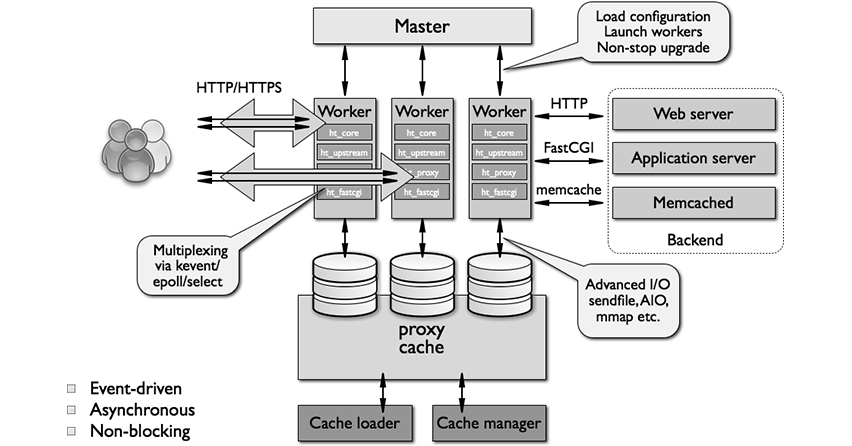NGiNX and Apache are two of the most widely used open source web server in the market today and are the usual top candidates for serving your PHP processes. One of the most common dilemmas developers have when deploying their work on servers is choice of web server.
Unfortunately, deciding on one of the two isn’t always a clear-cut process. You need in-depth understanding of the design architectures and working principles to make an informed decision.
Popularity Comparison
Apache has consistently been the faithful workhorse which enjoyed comprehensive dominance over all competitors for the last couple of decades. But it’s gradually falling out of favor with the modern-day web developer fraternity.
Although still the market leader in terms of sheer volume, Apache has been consistently losing ground to NGiNX over the recent years.
NGiNX’s reputation for being a compact, lightweight and fast web server immensely helped to seize the momentum.

And so far, it has managed to sustain the momentum in its favor.
Having said that, a direct comparison between the two in terms of general features and usage trends is unlikely to depict a clear picture. Both have their own advantages and drawbacks.
The most appropriate choice of web server for a particular website will depend on a number of external factors like the purpose of the website, web hosting platform, server hardware configuration, web technologies used and the estimated traffic volume.
Event-Driven versus Process Driven Architecture
The fundamental difference between NGiNX and Apache lies in their design architecture.

Disclaimer: NGiNX architecture diagram copyright of Aosabook
Apache employs a process-driven approach and creates a new thread for handling each connection request. NGiNX, on the other hand, is event-driven, which can handle multiple requests within one particular thread.
What is a thread? A thread is the smallest sequence of programmed instructions that can be managed independently by a scheduler. In most cases, a thread is a component of a process. Multiple threads can exist within one process, executing concurrently and sharing resources such as memory, while different processes do not share these resources.
As a result, NGiNX is significantly lightweight and easy on server resources. That’s precisely the reason behind web developers’ inclination towards NGiNX when it comes to serving a website with a large volume of traffic.
Benefits of using NGiNX over Apache
So what are the practical benefits of using an event-driven web server?
If you are wondering whether to ditch Apache in favor of NGiNX for hosting your high traffic website, then here are a few analytical insights that can help you to reach a logical conclusion to your dilemma.
1. NGiNX is Lenient on Primary Memory
As each new thread utilizes server resources (CPU, RAM & Bandwidth), Apache web servers end up consuming a higher amount of primary memory for handling simultaneous connection requests.
NGiNX employs a single-threaded approach, where concurrent connection requests are handled by a single worker process. As a result, a NGiNX server is far less severe on CPU and RAM utilization.
2. NGiNX Makes Use of Asynchronous I/O Handlers
Each worker process in NGiNX can handle thousands of connection requests concurrently due to its ability to handle I/O in an asynchronous manner. All the connection requests handled by NGiNX server are non-blocking and independent of one another.
Apache, on the other hand, refuses new connection requests once there is no more RAM available to support the creation of a new thread.

3. NGiNX Also Acts as a Software Load Balancer
NGiNX has the inbuilt support for load balancing connection requests to the application server. As a result, NGiNX can be a better choice for reducing latency by distributing load intelligently.
NGiNX also facilitates better control over failure events by removing failed backend services to free up the used server resources.
4. NGiNX is Faster at Serving Static Content
NGiNX is considered to be the industry leader when it comes to serving static web pages. In case a website receives large amount of connection requests simultaneously seeking static content, then NGiNX’s design architecture is better equipped to handle the load.
5. Optimized Usage of Hardware Resources
Since NGiNX server uses an asynchronous, non-blocking, event-driven connection handling algorithm, both the memory and CPU utilization tend to stay relatively consistent irrespective of the traffic volume.
As Apache consumes higher amount of RAM, it can serve fewer number of requests on the same hardware compared to NGiNX.
In other words, Apache requires more hardware resources for serving the same amount of users. For high traffic websites, it can lead to bottlenecks and connection drops. So NGiNX is a better option for optimizing the usage of limited hardware resources, which can lead to big savings on your hosting bill.
Final Takeaway
NGiNX’s architecture is better inherently a better webserver for handling high traffic websites efficiently. In some specific situations though, a combination of both NGiNX and Apache can be the best solution.
NGiNX is not necessarily a better webserver than Apache, it’s just different. It is always better to evaluate all the technical requirements carefully before taking a final call.



